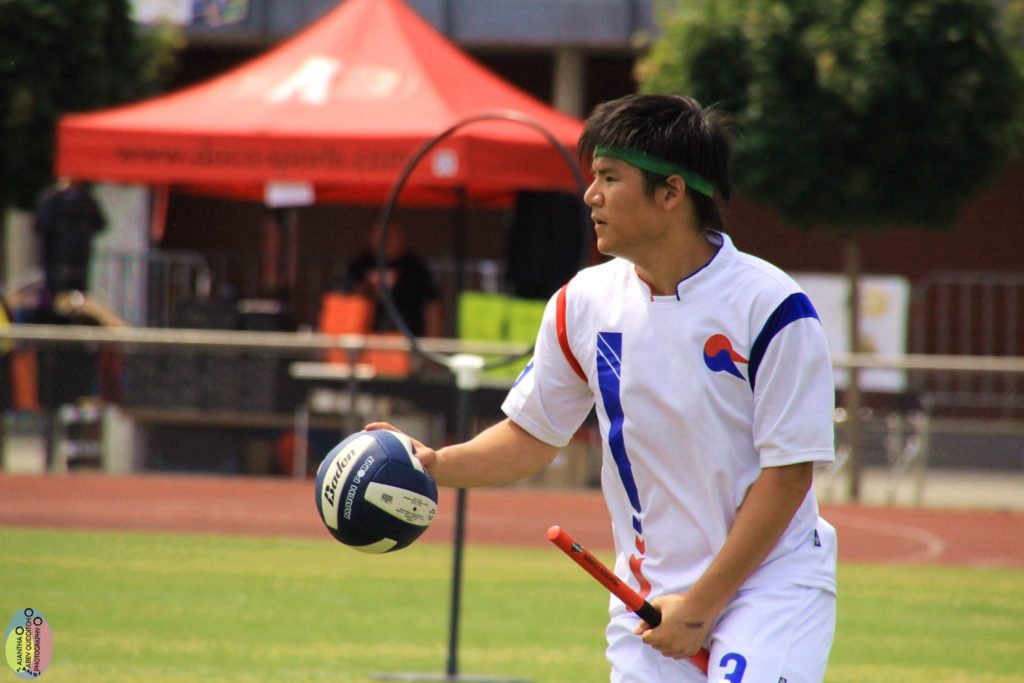Antwerp QC, Much of Belgian Core, Leaves Competitive Quidditch

Credit: Madison Seale, Nick May, Abbi Pittman
Friday should have been the quietest day of World Cup weekend, with just one exhibition match and the opening ceremonies on the schedule. However, a series of injuries, high temperatures and a late thunderstorm conspired to cast a shadow on the day. With the official opening match of the World Cup rapidly approaching, we take a look at the potential lasting effects of Friday’s action.
Outmanned, Outnumbered, Outplanned
Today’s exhibition match, between Brazil and South Korea, featured a pair of teams boasting just seven player rosters. Though things started out with some intriguing play, a pair of injuries on the Korean side of the field forced the Asian team’s hand, as they forfeited when they were down 150-60.
Much of that 90-point lead was developed with the snitch on pitch, particularly while South Korea’s Kyle Jeon was seeking, as the seeker floor played out to pretty much a draw. Jeon played both keeper and beater in the opening 18 minutes—and with the impressive play we saw from the team’s other beaters, he may continue to do so throughout the weekend. Unfortunately, much like the Mexican team the day before, the Koreans showed they will need to improve their poor snitch-on-pitch play—likely a result of their lack of physicality—if they hope to grab a win or two this weekend.
Unfortunately, with the circumstances surrounding the abrupt ending to this match, it’s difficult to focus just on the on-pitch results. With these exhibition matches, three major issues were thrust to the forefront of the community’s mind: why are there pre-tournament exhibitions to begin with, why are the seven-player teams playing in them and should seven-player teams be at World Cup at all?

Credit: Ajantha Abey Quidditch Photography
The value of the exhibitions is difficult to argue against, even if they seem illogical from a competitive perspective. With just one chance to market the intercontinental brand of the game every two years, it makes sense to expand that window to four days to attract more media attention. Still, teams like the USA were glad to not have to participate in such games, where there is little to gain and so much to lose. Along with the two South Korean injuries—neither of which appears to be too weekend ending—Erin McCrady’s broken collarbone looms large.
But the bigger issue than the existence of such exhibitions is having the teams with the smallest rosters participate in them. Obviously you want to match up teams from widely different areas, and those will often be the smallest teams. But if a match that needs two water timeouts just to keep the athletes safe still results in two injuries and a forfeit—and isn’t even official—maybe it isn’t worth doing.
The even bigger concern is whether there is worth to these seven-player teams at all. Obviously the international media attention can help expand the sport in such countries, but you have to imagine the thousands of dollars used to send those athletes to World Cup could have been used more effectively to promote the sport in other ways. There is no way a seven-player team can safely compete in a tournament in the modern age of quidditch. When games like this exhibition happen under the watch of the international community, the IQA needs to consider action if for no other reason than player safety. Raise the minimum number of players on a roster and, while the total number of teams may fall, the safety of the gameplay will rise.
Red, White, Black and Blue
We reported through Twitter early Friday morning that Team USA chaser Kaci Erwin had sustained a laceration of her leg during practice that, after receiving nine stitches, will keep her out for the remainder of the weekend. The injury was a freak accident, the result of an Erwin tackle that led to Simon Arends’ cleat contacting her leg.
While our best wishes are with Erwin, the question that is hard to shake is why was she ever tackling Arends in the first place. As I just laid out above, Team USA was thankful for avoiding an exhibition game and the chance for sustaining injuries—yet, here is the team practicing full physical contact the day before the tournament.
Obviously, this US squad has never had the opportunity to play together, and the practice is absolutely necessary. But tackling is an individual skill requiring no cohesion, and if America’s best still don’t have it down the day before the World Cup, there are far bigger issues. Stick to offensive drills, set up a man-to-man quaffle defense, rely on your players knowing how to tackle and go take home gold. It’s not that complicated.
But that formula was not followed, and the result is a two-woman rotation of Lindsay Marella and Julia Baer at chaser for the Americans. Both are amongst the very best in the country on the offensive side of the ball, but neither is known for their defensive play, particularly their physicality. Two years ago, the female chaser rotation for Team USA was all about physical play. Knowing that with the edge in the beating game and the talent of the team’s ball carriers, those female chasers recognized their skills were going to be most valuable on the defensive end. Now, Marella and Baer will need to step it up on that side of the ball if Team USA hopes to maintain its streak of never giving up a goal in the medal rounds of a World Cup. If they can’t, we might just see the tiniest chink in the American’s armor for the first time.
The Benepe In the Room
The opening ceremonies included a series of speeches from major contributors to the international quidditch community, but perhaps no one got as much praise from the assembled crowd as the sport’s founder, Alex Benepe. Benepe worked the crowd, played up the power of international play and welcomed everyone in several different languages.
If Benepe, who is now over a year removed from the sport, seemed like the most comfortable of the group, it’s because he very much is. Quidditch has never found another personality anything like Benepe’s. He was the sport’s first true star —“quidfamous” before that was even a term. People were legitimately excited just to get to talk to him, and, even today, people run up to him to ask for a picture.

Credit: Aurelie Lee’ Jacquin
Benepe exudes charisma. In a volatile, young sport, where every decision cannot possibly be popular, that charisma can buy you a lot of slack. Sure, he’s had his fair share of mishaps, including his cringeworthy cult of quidditch speech at World Cup VI. However, his approval ratings amongst anyone but the most hardcore of USQ insiders have always been sky high.
Today’s theme is shadows, and Benepe casts a long one across our sport. Even with his tenure as a quidditch administrator long over, he spoke today at the World Cup opening ceremonies and will travel next month to the MLQ Championship where the teams will compete for a trophy that bears his name. Meanwhile, players, volunteers and fans that know Benepe criticize decisions made by the sport’s current governing organizations which, without him, they see as a faceless bureaucracy.
No one has been able to be the outward face of good will that Benepe once embodied. Donte Quinine had his chance with USQ, but threw it away along with much of the American community’s trust. Questionable decisions from all-but-nameless IQA committees have brought out similar feelings. Now, everyone involved in running this sport must band together to get that trust back.
Archives by Month:
- April 2025
- May 2023
- April 2023
- April 2022
- January 2021
- October 2020
- September 2020
- July 2020
- May 2020
- April 2020
- March 2020
- February 2020
- January 2020
- December 2019
- November 2019
- October 2019
- August 2019
- April 2019
- March 2019
- February 2019
- January 2019
- November 2018
- October 2018
- September 2018
- August 2018
- July 2018
- June 2018
- April 2018
- March 2018
- February 2018
- January 2018
- November 2017
- October 2017
- July 2017
- June 2017
- May 2017
- April 2017
- March 2017
- February 2017
- January 2017
- December 2016
- November 2016
- October 2016
- September 2016
- August 2016
- July 2016
- June 2016
- May 2016
- April 2016
- March 2016
- February 2016
- January 2016
- December 2015
- November 2015
- October 2015
- September 2015
- August 2015
- July 2015
- June 2015
- May 2015
- April 2015
- March 2015
- February 2015
- January 2015
- December 2014
- November 2014
- October 2014
- September 2014
- August 2014
- July 2014
- May 2014
- April 2014
- March 2014
- February 2014
- January 2014
- November 2013
- October 2013
- September 2013
- August 2013
- July 2013
- June 2013
- May 2013
- April 2013
- March 2013
- February 2013
- January 2013
- December 2012
- November 2012
- October 2012
Archives by Subject:
- Categories
- Awards
- College/Community Split
- Column
- Community Teams
- Countdown to Columbia
- DIY
- Drills
- Elo Rankings
- Fantasy Fantasy Tournaments
- Game & Tournament Reports
- General
- History Of
- International
- IQA World Cup
- Major League Quidditch
- March Madness
- Matches of the Decade
- Monday Water Cooler
- News
- Positional Strategy
- Press Release
- Profiles
- Quidditch Australia
- Rankings Wrap-Up
- Referees
- Rock Hill Roll Call
- Rules and Policy
- Statistic
- Strategy
- Team Management
- Team USA
- The Pitch
- The Quidditch Lens
- Top 10 College
- Top 10 Community
- Top 20
- Uncategorized
- US Quarantine Cup
- US Quidditch Cup
